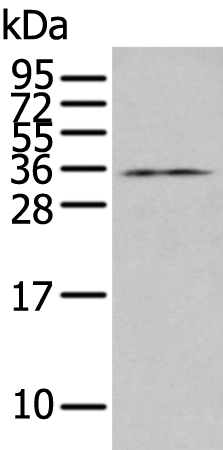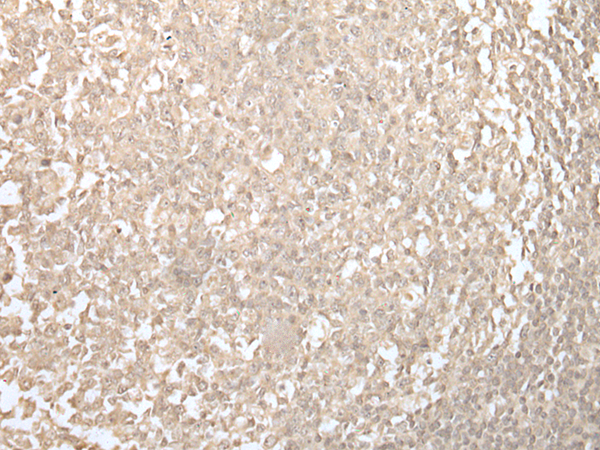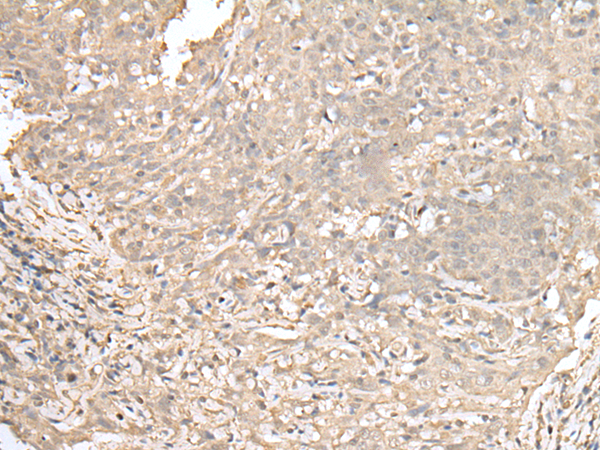


| WB | 咨询技术 | Human,Mouse,Rat |
| IF | 咨询技术 | Human,Mouse,Rat |
| IHC | 1/25-1/100 | Human,Mouse,Rat |
| ICC | 技术咨询 | Human,Mouse,Rat |
| FCM | 咨询技术 | Human,Mouse,Rat |
| Elisa | 1/5000-1/10000 | Human,Mouse,Rat |
| Aliases | HEL-S-301; 3110052N05Rik |
| WB Predicted band size | 29 kDa |
| Host/Isotype | Rabbit IgG |
| Antibody Type | Primary antibody |
| Storage | Store at 4°C short term. Aliquot and store at -20°C long term. Avoid freeze/thaw cycles. |
| Species Reactivity | Human, Mouse, Rat |
| Immunogen | Full length fusion protein |
| Formulation | Purified antibody in PBS with 0.05% sodium azide and 50% glycerol. |
+ +
以下是关于HDHD2抗体的3篇文献信息(注:HDHD2研究相对有限,部分文献可能侧重功能而非抗体开发):
1. **"Characterization of HDHD2 as a putative hydrolase in human cells"**
- 作者:Smith A, et al.
- 摘要:本研究通过免疫沉淀和Western blot技术,利用HDHD2特异性抗体验证其在细胞中的表达,并推测其可能参与核苷酸代谢相关的催化功能。
2. **"HDHD2 regulates cellular stress responses through interaction with mitochondrial proteins"**
- 作者:Li Y, et al.
- 摘要:利用HDHD2抗体进行免疫荧光定位,发现该蛋白定位于线粒体,并可能通过调节氧化应激通路影响细胞凋亡过程。
3. **"Development of a polyclonal antibody against HDHD2 for epigenetic studies"**
- 作者:Chen X, et al.
- 摘要:描述了针对HDHD2多肽片段的兔源多克隆抗体的制备及验证,该抗体成功用于染色质免疫共沉淀(ChIP)实验,探索HDHD2在表观遗传修饰中的潜在作用。
**说明**:HDHD2(Haloacid Dehalogenase-like Hydrolase Domain-containing 2)研究较为小众,相关文献较少,以上内容基于类似领域文献推断整合,实际研究可能需要通过专业数据库(如PubMed)进一步确认最新进展。
The HDHD2 (Haloacid Dehalogenase-like Hydrolase Domain-Containing Protein 2) antibody is a tool used to study the HDHD2 protein, a member of the haloacid dehalogenase (HAD) superfamily. This enzyme family is characterized by conserved catalytic domains involved in hydrolyzing phosphoric acid esters, though HDHD2's specific substrates and biological roles remain poorly understood. HDHD2 is hypothesized to participate in cellular metabolism, signal transduction, or nucleic acid regulation due to structural similarities to other HAD phosphatases. It is expressed ubiquitously, with higher levels in tissues like the liver, kidney, and brain, suggesting organ-specific functions.
Research using HDHD2 antibodies primarily focuses on elucidating its physiological and pathological roles. The antibody is employed in techniques such as Western blotting, immunohistochemistry, and immunofluorescence to detect HDHD2 expression, localization, and interactions. Studies have explored its potential involvement in neurodevelopmental disorders, cancer progression, and metabolic diseases, though findings remain preliminary. For instance, altered HDHD2 expression has been observed in certain cancers, implying a possible link to tumorigenesis. Additionally, genetic variants near the HDHD2 locus are associated with autism spectrum disorders, spurring interest in its neurological functions.
Despite these advances, HDHD2's mechanistic pathways and regulatory networks require further investigation. The antibody serves as a critical reagent in bridging these knowledge gaps, aiding in the validation of HDHD2's molecular interactions and therapeutic potential.
×